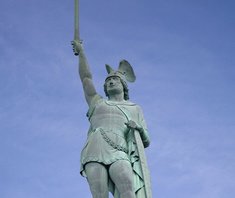Featured Quizzes
User Quizzes
Create Quiz
Data and Charts
Badges and Games
About JetPunk
JetPunk Shop
Dark Mode

North Rhine-Westphalia Quiz #2
How much do you know about the German state of North Rhine-Westphalia?
Rate:
Last updated: October 25, 2020
You have not attempted this quiz yet.
More quiz info >>
| First submitted | October 25, 2020 |
| Times taken | 29 |
| Average score | 60.0% | Report this quiz | Report |
4:00
Enter answer here
0
/ 15 guessed
Time Used
00:00
Best Time
00:00
The quiz is paused. You have remaining.
Scoring
You scored / = %
This beats or equals
% of test takers
also scored 100%
The average score is
Your high score is
Your fastest time is
Keep scrolling down for answers and more stats ...
|
camus
+1
Level 78
Oct 25, 2020
#1: The leader of the victorious army of Germanic tribes was Arminius - or Hermann, as he was later called (hence Herman ze German). His story became a national myth in the 19th century when the Holy Roman Empire was dissolved and the French ruled over large parts of the country (see #5). Germans wanted to see themselves as noble barbarians who would eventually throw out the invaders again. The statue you see on the thumbnail was erected in honor of Arminius/Hermann in 1875.
New and Popular
Save Your Progress
Copyright H Brothers Inc, 2008–2024
Contact Us | Go To Top | View Mobile Site
